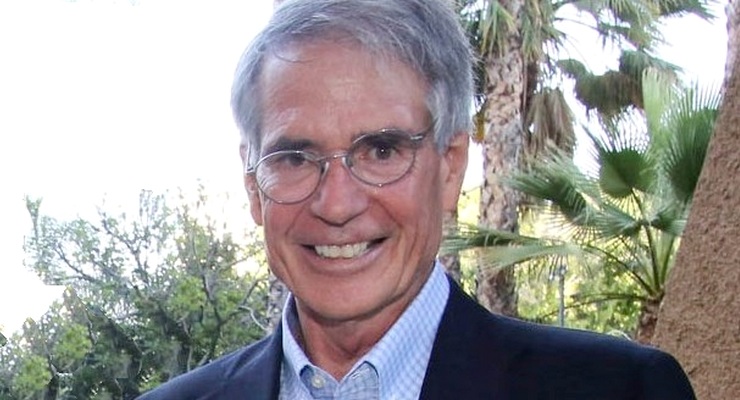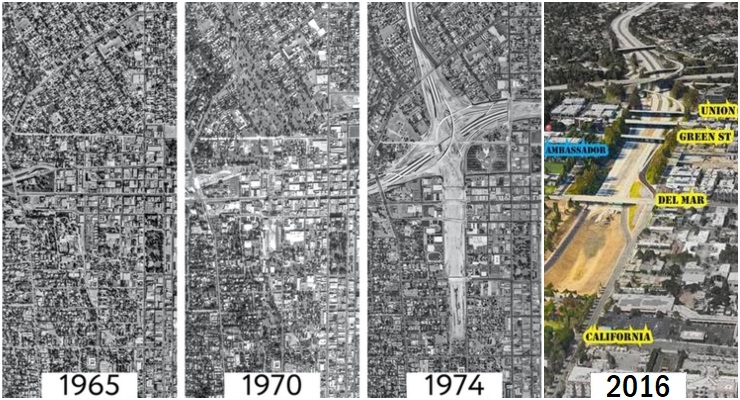The City Council will be deciding the fate of two controversial development projects next Monday night, July 22.* While the proposed buildings are in different parts of downtown and have different characteristics, they are similar in one very important policy matter: their proposed special exemption from review under the California Environmental Quality Act (CEQA), an expediting process known as the “Infill Exemption.”
In these cases, prior to even making a determination about the quality of the projects, the City Council, acting in a somewhat judiciary capacity, must decide that both projects warrant exemption from a detailed CEQA review. To do so, Council members must first find that each project is completely consistent with Pasadena’s General Plan policies and all zoning regulations, including the urban design elements of the Central Business District Plan. The only inconsistencies in these cases, under state court rulings, can be in the projects’ height and bulk.
This is a very high standard. The General Plan is the living constitution of our City. It is establishes how Pasadena is meant to grow in the future, how it should look and how it should function. The General Plan and zoning documents necessarily have some pretty subjective qualities, such as contextual architecture, respect for historic neighborhoods, traffic mitigations and non-monolithic massing of buildings. But most people involved in the public debate know what was intended by the General Plan. It is a document that required decades of compromises between neighborhood and downtown interests, civic activists and developers, growth advocates and preservationists, and these compromises have built a better Pasadena.
The City has been processing these two projects through the system fairly expeditiously, as projects go. Initially, staff determined that for a project to be exempt from CEQA, to meet the state-required standard of total “consistency” with the General Plan, decision-makers only had to evaluate a project’s quantifiable metrics, rules like setbacks from the property lines, driveway widths, and such. Under public pressure, however, the City acquiesced recently on one of these projects, determining that decision-makers review the qualitative aspects of a project’s consistency as well as the easily observed metrics. This makes more sense, because the State law requires not just a look at the rules of the General Plan, but specifically at the purpose, or the “policies.” Staff conducted a consistency review for this project on North Madison (adjacent to the historic Fuller campus) that Council will be wise to examine carefully. Developed by an outside consultant, the review appears exceedingly shallow, cherry-picking General Plan guidelines to find elements that were consistent, but avoiding blatant anomalies. It is more of an advocacy document than good analysis. But at least it is a step in the right direction.
Why is this policy issue important? What difference does expediting a project make if it make if helps reduce staff time? After all, CEQA is not a favorite state law for many Californians. CEQA places enormous burdens on developers to disclose detailed aspects of a project’s impact on the environment, such as traffic, air quality, noise and adjacent historic structures. It is often exploited by labor unions to negotiate better wage contracts, or used capriciously by NIMBY groups to oppose nearby projects that otherwise would serve the greater public good.
But CEQA is the law, and it is still the best tool Californians have to evaluate the quality of a project on the future growth of their community. Without CEQA, Pasadenans would have had two enormous 19-story towers built at the corner of Los Robles and Colorado back in the 1980’s, forever changing the small-town character of Pasadena’s historic downtown. Without CEQA, Pasadena would have had a very large suburban-style office building at the corner of El Molino and Colorado across from the Playhouse, rather than what was eventually built, arguably one of the most beautiful and appropriate commercial buildings developed in Pasadena since the pre-war years. There are multiple examples when CEQA has helped inform residents of a project’s problems, and allowed for a more intelligent debate.
With the two large projects going to Council July 22, despite considerable evidence that the projects will have significant impacts that have not been well analyzed or explained to the public, the City has so far avoided a deep look, going straight to the issue of the projects’ benefits, like affordable housing units. We certainly need more affordable housing units. But the issue shouldn’t be whether the project is good or bad until Council unequivocally determines the projects are eligible for a CEQA exemption, a step it cannot logically take at this point. Unlike some municipalities, we do not have a regularized process in place yet that requires the City to evaluate a project’s overall consistency with the General Plan policies and zoning and design guidelines before determining that it is eligible to avoid a full CEQA review.
A number of projects have been given Infill Exemptions in recent years, including two that our company proposed in 2015. Up until now, none have been terribly controversial. Decision-makers and civic leaders have known intuitively whether a project is basically consistent with the General Plan – meeting tests like contextual massing and architecture, housing fulfillment and mobility objectives. The view has been, “Let’s get these projects entitled and then let the Design Commission sort out other Plan and policy elements.” In general, this short-hand process has worked. Good examples are the new condominium project at Oakland and Cordova or an upcoming apartment building at El Molino and Union Street.
But the two projects before Council on July 22 present serious General Plan questions that have been raised by leading neighborhood groups, including the Madison Heights Neighborhood Association, Pasadena Heritage, the Women’s City Club and the Blinn House Foundation. One in particular has multiple conflicts, such as overshadowing an historic property, introducing a high ground floor parking garage which elevates the entire building (and creates an unattractive garage floor in a residential setting), failing to explore differentiated heights to break up massing. These are all incompatible elements with the General and Specific Plans. The other project on South Los Robles, which is more compatible with the General Plan architecturally, doesn’t appear to satisfy noise and traffic goals, or at least the City doesn’t appear to have objectively evaluated the issues.
Rather than stepping back and adopting a formal consistency review prior to giving a project the go-ahead, the City is advocating adoption of these projects and deflecting the real legal question, whatever their own attorneys advise otherwise: do these projects merit an exemption? A good case isn’t being made. The issue isn’t yet whether they should ultimately be built, but whether Council members, in their hearts, can make the determination that the projects are completely “consistent with the “all applicable general plan policies as well as with applicable zoning regulations” as required under State law.
CEQA has limitations. Even with a deeper CEQA review, both projects might be found to merit Council approval. But shortcutting the process isn’t a good answer for Pasadena. We have invested mightily in a good General Plan over decades, and Council’s first responsibility should be to insure it is upheld, that projects meet broader community objectives before they become eligible for exemption from CEQA evaluation, as state law requires.
Ken McCormick is a long-time Pasadena resident with an interest in civic affairs, having served on numerous City commissions. A former banker, he started Mill Creek Planning & Development to help activate the Playhouse District.
*The two hearings referenced are:
July 22, 2019, 7:00 p.m. – Call for Review of a Board of Zoning Appeals Decision to the City Council Regarding Affordable Housing Concession Permit No. 11869 to Facilitate the Construction of a New 94,165 Square-Foot, Six-Story, 92-Unit, Multi-Family Residential Building (Including Eight “Very Low Income Units”), with 131 Parking Spaces in a Three-Level Subterranean Parking Garage for the Property Located at 253 South Los Robles Avenue
July 22, 2019, 7:00 p.m. – Appeal of Board of Zoning Appeals’ Decision on Affordable Housing Concession Permit No. 11879 to Facilitate the Construction of a 72,000 Square-Foot, Five-Story Mixed-Use Project Consisting of 49 Residential Units (Including Four Units Dedicated To “Very-Low Income” Households), 4,210 Square Feet of Commercial Floor Area, and 101 Parking Spaces for the Properties Located at 127 & 141 N. Madison Avenue

















